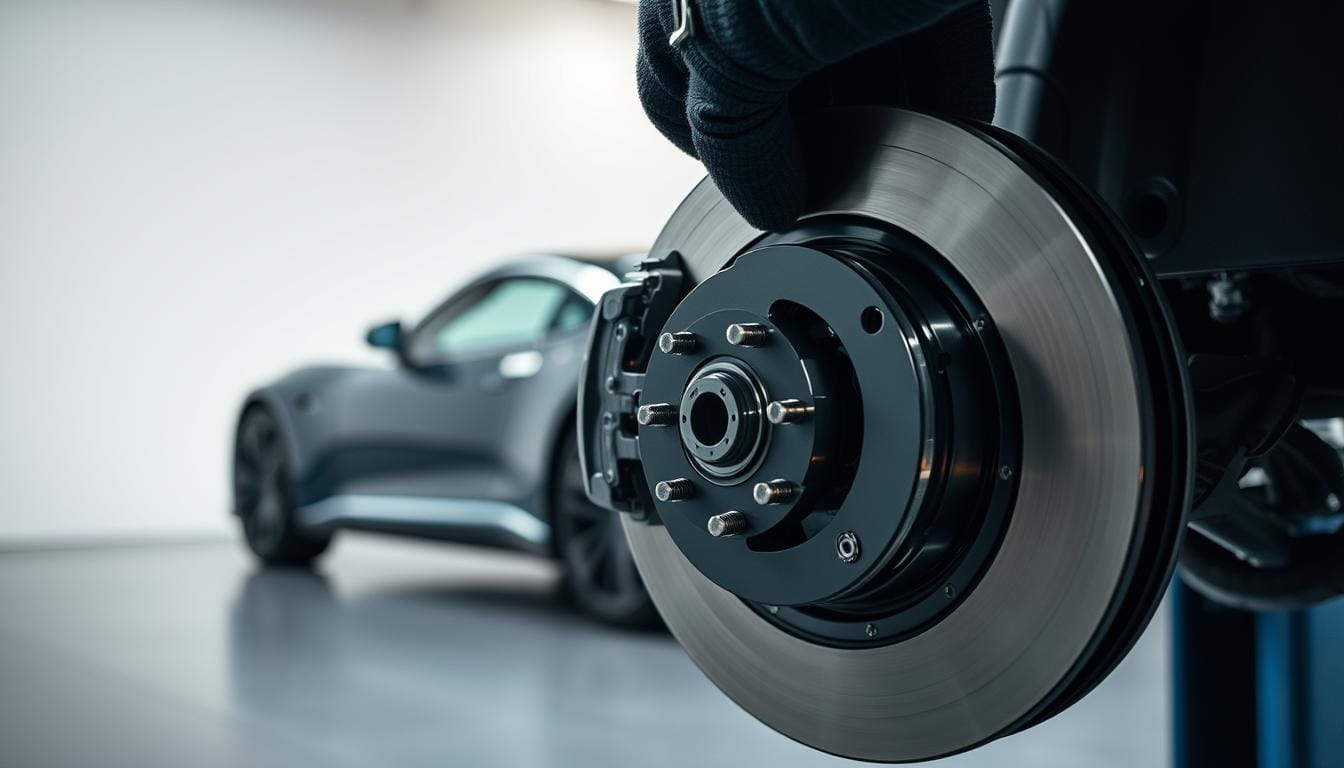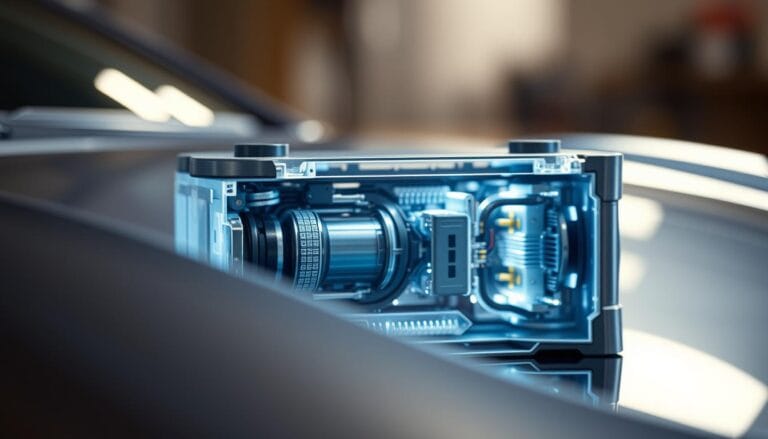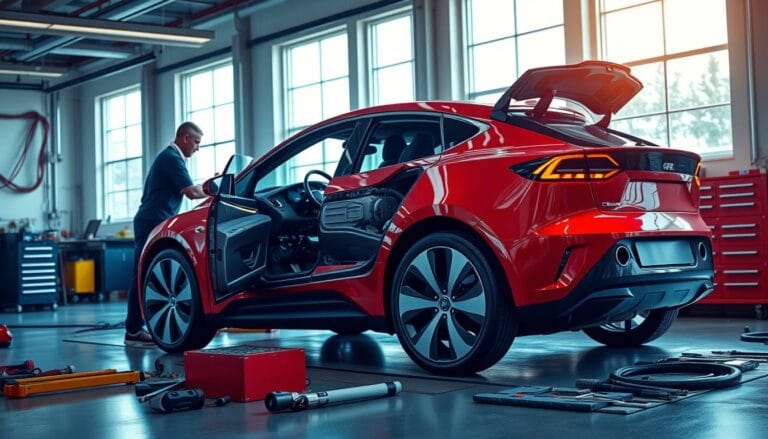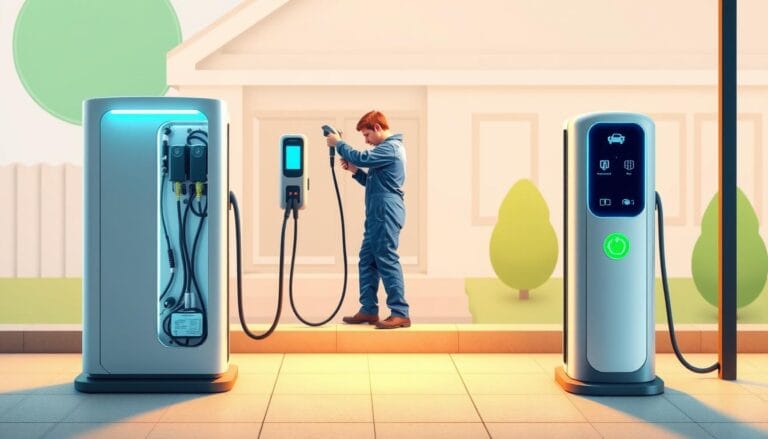EV Brake Maintenance: Caring for Regenerative Systems
Driving an electric vehicle is more than just a technological marvel—it’s a commitment to maintaining a sophisticated braking system. This system operates differently from traditional cars. Every time you press the brake pedal, your EV brake maintenance becomes a critical aspect of ensuring peak performance and safety.
Electric vehicles represent a revolutionary approach to transportation. They have regenerative braking systems that dramatically change how we think about vehicle stopping power. These advanced systems not only slow your vehicle but also capture energy to recharge your battery. This makes them a game-changer in automotive technology.
Understanding the nuances of EV brake maintenance can save you thousands in repairs. It ensures your vehicle remains in top condition. Proper care of your electric vehicle’s braking system is an investment in long-term reliability and performance.
Table of Contents
Understanding EV Braking Systems
Electric vehicles are changing how we travel, thanks to their braking systems. These systems do more than just stop the car. They manage energy and improve performance.
The brake system in electric vehicles is different from traditional cars. It uses regenerative braking to slow down and save energy.
What is Regenerative Braking?
Regenerative braking turns the car’s motor into a generator when you slow down. This happens when you take your foot off the gas or press the brake gently. The motor then captures energy and puts it back into the battery.
- Converts kinetic energy into electrical energy
- Charges the vehicle’s battery during slowing down
- Reduces wear on traditional brake components
How Regenerative Braking Works
Regenerative braking is amazing. When you slow down, the motor works in reverse. It creates resistance to stop the car and also makes electricity to charge the battery.
| Braking Stage | Energy Conversion | Battery Impact |
|---|---|---|
| Acceleration | Electric energy to kinetic motion | Battery discharges |
| Deceleration | Kinetic motion to electrical energy | Battery recharges |
Differences Between Traditional and EV Brake Systems
Traditional cars use friction brakes to slow down. Electric vehicles, on the other hand, use regenerative braking. This can make your car go up to 20% farther and wear out less.
Regenerative braking is present in basically 100% of electric vehicles, showing its key role in EV design.
Knowing how electric vehicle brakes work helps you see the advanced tech in today’s cars. It also helps keep your car running at its best.
Importance of Regular Brake Maintenance
Keeping your electric vehicle’s brakes in top shape is key for safety and performance. EV Brake Maintenance is more than just routine checks. It’s about safeguarding your vehicle’s most vital safety parts.
Even with regenerative braking, regular brake checks are vital for your car’s best performance. Almost 25% of drivers miss out on brake maintenance, which can be risky.
Enhancing Safety and Performance
Your EV’s brakes need regular care to stay at their best. Important maintenance tasks include:
- Inspecting brake pads every 8,000 kilometers
- Checking brake fluid annually
- Monitoring electronic brake components
- Preventing system failures
Extending the Lifespan of Braking Components
Regular upkeep can make your brakes last longer. Here are some key facts:
- Brake pads usually last 30,000 to 70,000 miles
- Preventive care can save up to $1,000 in repair costs
- Professional checks spot issues early
70% of brake-related accidents could be prevented with consistent maintenance and timely inspections.
By focusing on brake safety, you protect your investment. You also keep your electric vehicle safe and efficient on the road.
Key Components of EV Brake Systems
Electric vehicles are a technological wonder, with their brakes being a standout feature. Knowing the main parts of an EV’s brake system is key to keeping your car safe and running well.
Modern electric cars have a complex brake system. It’s different from what you find in gas cars. These systems aim to be efficient and last longer.
Brake Pads and Rotors
Replacing brake pads in EVs is special because of regenerative braking. EVs don’t wear out brake pads as much because the electric motor helps slow them down.
- Brake pads in EVs are made from tougher materials
- Regenerative braking cuts down on brake use by up to 70%
- Special brake pad materials help them last longer
Regenerative Braking System Components
Regenerative braking turns the car’s movement into electricity, which goes into the battery. This system has important parts:
- Parts that change energy types
- Power inverters
- Batteries to store energy
- Smart systems to manage energy
Electronic Control Units (ECUs)
The Electronic Control Unit is the brain of your EV’s brakes. These advanced computers watch over and fine-tune brake performance. They make sure your car brakes efficiently and safely.
Learning about these parts helps you take care of your electric car. It also shows you the clever engineering behind its brakes.
Signs Your EV Needs Brake Maintenance
Keeping your electric vehicle’s brakes in top shape is key for safety and performance. Electric vehicle owners must stay vigilant about brake issues that could affect driving safety. Regular brake system diagnostics are vital to catch problems early.
Your electric vehicle sends out signals when it has brake problems. Spotting these signs early can save you from expensive repairs and keep your brakes safe.
Unusual Noises During Braking
Pay close attention to the sounds your EV makes when you brake. Look out for:
- Grinding noises that mean your brake pads are worn out
- Squeaking sounds that could mean friction issues
- Metallic scraping that needs immediate attention
Dashboard Warning Indicators
Modern EVs have advanced diagnostic systems. Watch for dashboard lights that signal brake problems:
- Brake warning light turning on
- ABS indicator flashing
- Error messages about brake performance
Physical Braking Sensations
Your vehicle’s physical response can show brake maintenance needs. Look out for:
- Vibrations when you brake
- The vehicle pulling to one side when stopping
- A soft or unresponsive brake pedal
Regular brake system diagnostics can catch issues early. Most electric vehicles suggest annual brake checks to keep performance high and ensure your safety.
Routine Maintenance Practices for EV Brakes
Keeping your electric vehicle’s brakes in check is key for safety and performance. EVs need special care due to their unique parts and maintenance needs.
Checking your EV’s brakes is more than just looking at parts. The regenerative braking system needs extra attention to keep your EV running well.
Regular Brake Inspections
Your EV’s brakes should be checked often. Experts suggest regular electric vehicle brake inspections at these times:
- Every 7,500 miles: Detailed brake system check
- Quarterly visual brake component assessment
- Annual complete brake system evaluation
Brake Fluid Replacement Guidelines
Replacing brake fluid is vital for EV upkeep. Even with less brake wear, fluid quality is key for system performance.
| Maintenance Interval | Recommended Action |
|---|---|
| Every 2-3 years | Complete brake fluid replacement |
| Annually | Brake fluid quality inspection |
Keeping Brake Components Clean
Clean brake parts last longer. Gentle cleaning and lubricating brake calipers can stop wear and performance problems.
“Preventive maintenance is the key to long-lasting EV brake performance.” – EV Maintenance Experts
By sticking to these maintenance steps, your EV’s brakes will stay in great shape. This could save you thousands in repair costs.
Tools Needed for Brake Maintenance
Maintaining your electric vehicle’s brakes needs special tools and knowledge. Professional brake system diagnostics keep your EV safe and running well. Knowing the right tools is key for good vehicle care.

For EV brake parts, you’ll need both basic and special tools. This keeps your vehicle in great shape.
Essential Tools for EV Owners
- Safety equipment (protective gloves and goggles)
- Wheel chocks
- Jack and jack stands
- Torque wrench
- Brake cleaner spray
- Brake pad compressor
Diagnostic Tools for EV Brake Systems
Technicians use advanced tools to find brake issues in EVs. These tools offer deep insights into regenerative braking.
- Specialized scanning tools for electronic brake control units
- Digital multimeters
- Pressure testing equipment
- Brake fluid analysis tools
Brake system diagnostics are key for spotting wear or problems early. Experts suggest checking brakes every 10,000 miles. This keeps your EV safe and performing well.
Investing in proper tools and regular maintenance can prevent costly repairs and ensure your electric vehicle’s long-term reliability.
DIY vs Professional Brake Maintenance
Electric vehicle owners face a tough choice in EV brake maintenance. It’s key to know when to do it yourself and when to call a pro. This ensures your car stays safe and runs well.
Choosing between DIY and professional brake care depends on your skills, tools, and the job’s complexity.
Advantages of DIY Maintenance
- Significant cost savings compared to professional services
- Lower maintenance expenses for brake system diagnostics
- Develop personal understanding of your EV’s brake system
DIY brake care can cut repair costs by up to 50%. For simple tasks like checking brake pads, you can save a lot.
When to Seek Professional Help
| Scenario | Recommended Action |
|---|---|
| Complex Electronic Brake Systems | Professional Diagnosis Required |
| Regenerative Braking Issues | Specialized Technician Needed |
| Advanced Diagnostic Requirements | Professional EV Brake Maintenance |
Do routine checks every six months. Brake fluid levels, pad thickness, and wear indicators are key to EV brake care.
For DIY brake work, you’ll need a socket wrench set, brake caliper tool, and open-end wrenches. Always check your car’s manual for specific needs and torque values.
Safety first: If unsure about any brake task, get a professional EV tech’s help.
Common Myths About EV Brake Systems
Electric vehicles have led to many misconceptions about their upkeep, mainly about regenerative braking systems. EVs bring great tech benefits, but knowing the truth about their brakes is key for good car care.
Let’s look at some common myths about EV brake care and find out what’s real:
- Myth: EVs Never Need Brake Maintenance
- Myth: Regenerative Braking Eliminates Brake Wear Completely
- Myth: EV Brake Systems Are Identical to Traditional Vehicles
Debunking Misconceptions
Many think EVs never need brake checks. But, regenerative braking systems do help, but they don’t stop brake wear completely. EVs can last up to 200,000 miles before needing brake replacements, compared to regular cars.
| Brake System Type | Typical Replacement Interval | Maintenance Cost |
|---|---|---|
| Traditional Vehicle Brakes | 50,000-70,000 miles | $300-$800 |
| EV Brake Systems | 100,000-200,000 miles | $100-$300 |
Facts vs. Fiction: Understanding Your EV
EV brakes are different from regular brakes. Even with regenerative braking, regular checks are needed. Your EV’s brakes need expert care to work best and stay safe.
“Understanding your EV’s unique brake system is key to long-term reliability and performance.” – EV Maintenance Expert
Looking after your EV’s brakes is more than just stopping wear. It’s about keeping your car running smoothly and safely for years.
Environmental Impact of Brake Maintenance
Electric vehicles are a big step towards cleaner transport. But, their brakes can harm the environment. Knowing how EV brake maintenance affects the planet helps us choose greener options.

Even electric cars pollute through brake dust. Studies show that tiny particles from brakes can be as harmful as diesel fumes. Brake dust is a big problem for air quality.
Reducing Brake Dust Pollution
How you maintain your EV’s brakes matters for the planet. Using regenerative braking saves a lot of energy. It cuts down on brake dust by up to 70%.
| Brake Pad Type | Toxicity Level | Environmental Impact |
|---|---|---|
| Low Metallic | High | Significant particulate emissions |
| Non-Asbestos Organic | Highest | Most toxic to human lung cells |
| Hybrid-Ceramic | Moderate | Reduced environmental impact |
Sustainable Practices for EV Owners
To lessen your EV’s environmental impact, follow these tips:
- Opt for eco-friendly brake pads
- Use regenerative braking
- Check brakes regularly
- Dispose of old brake parts correctly
Remember, taking care of your EV’s brakes helps the planet too.
Special Considerations for All-Wheel Drive EVs
All-wheel drive (AWD) electric vehicles are a big step forward in car tech. They offer both unique challenges and benefits. These cars use advanced electric motors and complex brake systems that need special care during inspections.
AWD EVs have special performance perks that make them stand out. They have electric motors on both front and rear axles. This setup requires specific maintenance that owners should know about.
Brake System Complexity in AWD EVs
The brakes in AWD electric vehicles are more complex than usual. Brake rotor resurfacing is key because of the advanced power distribution. Some main complexities include:
- Multiple electric motors needing to brake together
- Advanced torque vectoring tech
- Integrated regenerative braking systems
- More complex electronic control units
Maintenance Tips for AWD Models
Keeping your AWD EV’s brakes in top shape is vital for safety and performance. Here are some tips from the experts:
- Do regular brake inspections every 12,000 miles
- Check brake fluid levels and condition every year
- Watch for brake pad wear on all wheels
- Use the right brake rotor resurfacing methods
Knowing these special needs helps you get the most out of your AWD EV. It ensures safety, performance, and longevity while avoiding maintenance issues.
Cost of Brake Maintenance for Electric Vehicles
Electric vehicles (EVs) save money on maintenance. Knowing how much brake maintenance costs helps you take better care of your EV.
EVs are cheaper to maintain than gas cars. They cost about 50% less for upkeep. This is thanks to their advanced brakes, like regenerative braking.
Comparing Maintenance Expenses
Here’s how EVs compare to gas cars in maintenance costs:
- EV maintenance cost: $0.031 per mile
- Traditional vehicle maintenance cost: $0.061 per mile
- Average lifetime maintenance for EVs: $4,600
Budgeting for Brake Maintenance
Planning for brake pad and caliper maintenance is key. Regular checks and early action can save you money.
“Preventative maintenance is key to managing EV brake system costs effectively.”
Popular EVs like the Ford Mustang Mach-E show big savings. They need less maintenance and cost less over time. This makes them a smart choice for those watching their budget.
Cost-Saving Tips
- Schedule annual brake system inspections
- Utilize regenerative braking to reduce wear
- Follow manufacturer-recommended maintenance schedules
- Address any issues quickly
By planning for brake maintenance, you can keep your EV running well and save money.
Future Trends in EV Brake Technology
Electric vehicle brake technology is changing fast, with regenerative braking leading the way. These systems can now grab about 70% of energy lost during braking. This makes cars more efficient. Expect future EVs to use smarter energy management for better brakes and battery control.
Artificial intelligence is changing brake safety checks in big ways. New sensors let cars check themselves in real time. This means cars can fix problems before they cause trouble. Brake-by-wire systems are also coming, making brakes more precise and working well with car electronics.
The market for car brakes is expected to grow a lot, reaching USD 30.1 billion by 2028. This growth comes from higher safety standards and more advanced braking systems. Your next EV might have lighter parts like aluminum calipers for better stability and less weight.
New tech like Electro-Hydraulic Braking Systems (EHBS) and Brake-by-Fiber Technology will change braking forever. With better regenerative braking, you’ll see more efficient cars, longer drives, and a greener ride.







